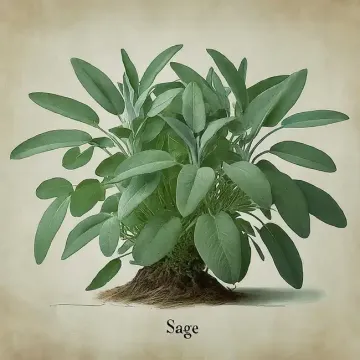Sage, scientifically known as Salvia officinalis, is a perennial herb native to the Mediterranean region. It has been revered for centuries not only for its culinary applications but also for its medicinal properties. Sage is part of the mint family (Lamiaceae) and is closely related to other popular herbs like rosemary, thyme, and oregano. This hardy herb has velvety, grayish-green leaves and produces beautiful purple, blue, or white flowers that can attract pollinators to your garden.
History of Sage
The use of sage dates back to ancient times. The ancient Egyptians used it as a fertility drug, while the Greeks and Romans considered it a sacred herb. It was used in religious rituals, and its name, derived from the Latin word "salvere," means "to save," indicating its perceived healing properties. During the Middle Ages, sage was believed to ward off evil and protect against witchcraft. Its reputation as a medicinal herb was so strong that it was often referred to as "sage the savior."
Health Benefits of Sage
Sage is rich in antioxidants and anti-inflammatory compounds, making it a powerful herb for health. Some of the health benefits include:
- Improved Digestion: Sage has been traditionally used to aid digestion, reduce bloating, and soothe stomach pains.
- Cognitive Health: Studies suggest that sage can enhance memory and cognitive functions, potentially benefiting those with Alzheimer's disease.
- Anti-inflammatory Properties: The herb has anti-inflammatory effects, which can help reduce symptoms of inflammation-related conditions.
- Oral Health: Sage has antimicrobial properties that can help fight off bacteria in the mouth, making it useful for oral health.
- Menopausal Symptoms Relief: Sage is often used to reduce hot flashes and other symptoms of menopause.
Culinary Uses of Sage
Sage is a versatile herb in the kitchen, known for its earthy and slightly peppery flavor. It pairs well with a variety of dishes, particularly those that are rich and hearty. Common culinary uses of sage include:
- Seasoning for Meat: Sage is often used to flavor poultry, pork, and sausage dishes.
- Stuffing: Sage is a classic ingredient in stuffing, especially in holiday recipes.
- Butter and Sauces: Sage-infused butter or sauces can elevate pasta, gnocchi, and roasted vegetables.
- Herbal Teas: Sage can be used to make a soothing tea that is both aromatic and beneficial for digestion.
Growing Tips for Sage
Sage is a resilient and easy-to-grow herb that can thrive in various conditions, making it a great addition to any home garden. Here are some tips to help you grow sage successfully:
- Sunlight: Sage prefers full sun but can tolerate partial shade. Ensure it gets at least 6 hours of sunlight per day.
- Soil: Sage thrives in well-drained soil with a pH between 6.0 and 7.0. It prefers slightly sandy or loamy soil.
- Watering: Sage is drought-tolerant once established. Water the plant regularly but allow the soil to dry out between watering to prevent root rot.
- Spacing: Plant sage about 18-24 inches apart to allow for good air circulation.
- Pruning: Regularly prune sage to encourage bushier growth and to prevent the plant from becoming woody.
- Harvesting: You can start harvesting sage once the plant has enough mature leaves. Harvest in the morning after the dew has dried for the best flavor.
- Winter Care: Sage is hardy and can withstand frost. In colder climates, consider covering the plants with mulch to protect them during the winter.
Conclusion
Growing sage in your home garden is a rewarding experience. Not only does it offer a wealth of health benefits, but it also adds a unique flavor to your culinary creations. With minimal care, this resilient herb can thrive in a variety of garden settings, providing you with fresh sage leaves for years to come.

